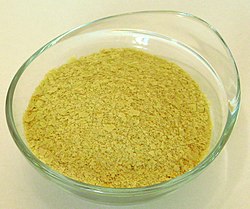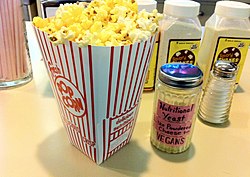Nutritional yeast


| Nutritional value per 15 g | |||||||||||||||||||||||||||||||
|---|---|---|---|---|---|---|---|---|---|---|---|---|---|---|---|---|---|---|---|---|---|---|---|---|---|---|---|---|---|---|---|
| Energy | 250 kJ (60 kcal) | ||||||||||||||||||||||||||||||
5 g | |||||||||||||||||||||||||||||||
| Sugars | 0 g | ||||||||||||||||||||||||||||||
| Dietary fibre | 3 g | ||||||||||||||||||||||||||||||
0.5 g | |||||||||||||||||||||||||||||||
8 g | |||||||||||||||||||||||||||||||
| |||||||||||||||||||||||||||||||
| Other constituents | Quantity | ||||||||||||||||||||||||||||||
| Cholesterol | 0 mg | ||||||||||||||||||||||||||||||
Bob's Red Mill brand, manufacturer reported values.[1]
See also SR LEGACY data for yeast (active dry #1103594) for an idea about pre-fortification values and nutrients not reported above. SR surveys are performed by unbiased USDA personnel. | |||||||||||||||||||||||||||||||
| †Percentages estimated using US recommendations for adults,[2] except for potassium, which is estimated based on expert recommendation from the National Academies.[3] | |||||||||||||||||||||||||||||||
Nutritional yeast (also known as nooch[4]) is a deactivated (i.e. dead) yeast, often a strain of Saccharomyces cerevisiae, that is sold commercially as a food product. It is sold in the form of yellow flakes, granules, or powder, and may be found in the bulk aisle of natural food stores. It is used in vegan and vegetarian cooking as an ingredient in recipes or as a condiment.[5]
It is a source of some B-complex vitamins and contains trace amounts of several other vitamins and minerals.[6] It may be fortified with vitamin B12.
Nutritional yeast has a strong flavor described as nutty or cheesy for use as a cheese substitute. [7] It may be used in preparation of mashed potatoes or tofu.[8]
Nutritional yeast is a whole-cell inactive yeast that contains both soluble and insoluble parts, which is different from yeast extract. Yeast extract is made by centrifuging inactive nutritional yeast and concentrating the water-soluble yeast cell proteins which are rich in glutamic acid, nucleotides, and peptides, the flavor compounds responsible for umami taste.[citation needed]
Commercial production
[edit]Nutritional yeast is produced by culturing yeast in a nutrient medium for several days. The primary ingredient in the growth medium is glucose, often from either sugarcane or beet molasses. When the yeast is ready, it is killed with heat and then harvested, washed, dried and packaged. The species of yeast used is often a strain of Saccharomyces cerevisiae.[9] The strains are cultured and selected for desirable characteristics and often exhibit a different phenotype from strains of S. cerevisiae used in baking and brewing.[10]
Nutrition
[edit]In a reference amount of 15 g (0.53 oz), one manufactured, fortified brand is 33% carbohydrates, 53% protein, and 3% fat, providing 60 calories (table). Levels of B vitamins in the reference amount are multiples of the Daily Value (table).
Nutritional yeast contains low amounts of dietary minerals (source in table), unless fortified.[11]
There may be confusion about the source of vitamin B12 in nutritional yeast, as yeast cannot produce B12, which is naturally produced only by some bacteria.[12] When it is fortified, the vitamin B12 (commonly cyanocobalamin) is produced separately and then added to the yeast.[citation needed]
See also
[edit]References
[edit]- ^ "FoodData Central #1946780". fdc.nal.usda.gov. Archived from the original on 3 April 2019. Retrieved 26 January 2022.
- ^ United States Food and Drug Administration (2024). "Daily Value on the Nutrition and Supplement Facts Labels". FDA. Archived from the original on 27 March 2024. Retrieved 28 March 2024.
- ^ National Academies of Sciences, Engineering, and Medicine; Health and Medicine Division; Food and Nutrition Board; Committee to Review the Dietary Reference Intakes for Sodium and Potassium (2019). "Chapter 4: Potassium: Dietary Reference Intakes for Adequacy". In Oria, Maria; Harrison, Meghan; Stallings, Virginia A. (eds.). Dietary Reference Intakes for Sodium and Potassium. The National Academies Collection: Reports funded by National Institutes of Health. Washington, DC: National Academies Press (US). pp. 120–121. doi:10.17226/25353. ISBN 978-0-309-48834-1. PMID 30844154. Retrieved 5 December 2024.
- ^ Hughes, Becky (8 May 2020). "Nutritional Yeast Is for Hippies. 'Nooch' Is for Everyone". The New York Times. Retrieved 3 October 2022.
- ^ Brown, Elizabeth (25 April 2009). "Singing the praises of nutritional yeast". Santa Monica Daily Press. Retrieved 7 October 2012.
- ^ "Large flake nutritional yeast". USDA Branded Food Products Database. United States Department of Agriculture. Retrieved 26 September 2018.[dead link]
- ^ Stepaniak, Joanne (2003). The Ultimate Uncheese Cookbook (10th ed.). Summertown, Tenn.: Book Pub. Co. p. 32. ISBN 978-1-57067-151-7.
- ^ Wasserman, Debra (1997). Conveniently Vegan (Revised. ed.). Baltimore, Md.: Vegetarian Resource Group. p. 29. ISBN 978-0-931411-18-2.
- ^ Industrial Exploitation Of Microorganisms. New Delhi: I.K. International Pub. House. 2010. p. 6. ISBN 9789380026534.
- ^ "'Definite parmesan cheese vibes': how to cook with nutritional yeast". The Guardian. Guardian News & Media Limited. 22 September 2022. Retrieved 17 October 2024.
Nutritional yeast (affectionately known as nooch) ... Unlike baker's yeast, it can't be used as a raising agent, and it's also different to the food supplement – dried brewer's yeast – which has a bitter taste.
- ^ Grumezescu AM, Holban AM (2018). Diet, microbiome and health. London, United Kingdom: Academic Press. ISBN 978-0-12-811492-6. OCLC 1018307483.
- ^ Fang, Huan; Kang, Jie; Zhang, Dawei (30 January 2017). "Microbial production of vitamin B12: a review and future perspectives". Microbial Cell Factories. 16 (1): 15. doi:10.1186/s12934-017-0631-y. ISSN 1475-2859. PMC 5282855. PMID 28137297.

